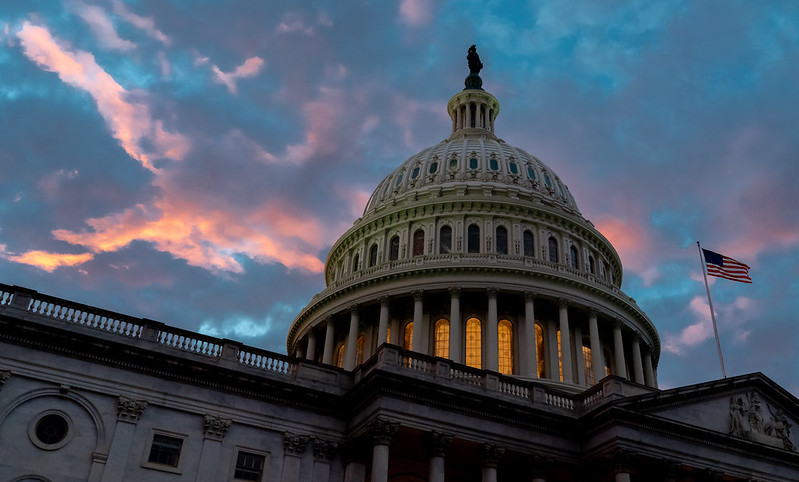If we really want to solve the climate crisis, the time has come for companies to push for federal policies that reduce greenhouse gas emissions in line with the Paris Agreement.
In recent months stakeholders across the spectrum – investors, employees and companies – have championed climate action, especially where it intersects with corporate political accountability.
On October 15, we at WRI joined 10 partners in the environmental and sustainable business space to introduce the AAA Framework, which calls on companies to advocate for smart policies based in science, align their trade associations with this position, and allocate political spending to advance these outcomes. Setting strong internal goals, while commendable, won’t by itself deliver rapid emissions reduction we need. That will require effective federal policy.
WRI has long been active on the role of corporate engagement in policy, and trade associations in particular, which fits squarely within the align component of the AAA Framework. In 2013 we jointly released a Guide for Responsible Corporate Engagement in Climate Policy, to which 130 companies have made a public commitment, followed by The Ambition Loop report in 2018, which describes how business and government can work to mutually reinforce one another in pursuit of zero carbon economic growth. This is a topic we bring up often with the companies in our network and an area where we support and empower our partners.
What Does Good Trade Association Alignment Look Like?
We see two different paths on the road to trade association alignment, but they both start with the same step: a thorough accounting of your company’s current position. How does your company’s stance on climate change compare to that of the organizations you pay to represent your interests? For most of you, we suspect this analysis will fall short of a 100% match. For a few, this may be a deliberate strategy to draw praise for a climate-friendly reputation while allowing a trade association to ensure a ”business as usual” environment. For others, we hope most, misalignment is inadvertent, a lack of awareness of the climate stance and impact of your trade association. And some of you may be aware of the difference, but have made a conscious decision to stay a member because other issues the association addresses are also important.
We know companies have many issues to juggle, and that representation on one issue can outweigh misrepresentation on another. However, on climate, we don’t have time to waste.
If an audit of your trade association memberships reveals misalignment, the leadership criteria of our new framework offers a choice. Leave an association due to differences on climate, or stay and effect change from within. Here are five steps your company can take to make sure this happens:
1) Conduct an Audit
Complete a thorough assessment of your associations’ positions on climate change, as compared to internal company positions. Make the audit results public and commit to re-auditing associations on a regular basis.
2) Develop a Strategy
Armed with information on areas of misalignment, make a plan to self-correct, including developing criteria for how to make decisions around association membership. What conditions must be present for you to leave? What conditions must be present for you to stay and commit to changing your association’s position from within? Be clear. Set up explicit criteria for what success looks like and appropriate timelines for affecting change.
3) Speak Out
When a trade association speaks or acts on a climate issue with which you disagree it is no longer sufficient to point at your company’s own words and actions and say it is clear you have a different position. Tell your association’s leaders that they cannot claim or even imply they represent you on climate. Every time they take action or make a statement that goes counter to your position, make that difference explicit, publicly.
4) Leave, If Necessary
Trying to achieve alignment through engagement may not pay off. Following criteria outlined in your company’s strategy, leave associations where attempts to change prove ineffective or insufficient and/or where leaving is perceived to be most aligned with company goals and climate needs.
5) Be Transparent
Publicly disclose all positions, actions and outcomes, including listing all trade association memberships, audit results and efforts to hold associations accountable.
The AAA Framework raises the bar when it comes to corporate leadership on climate change. However, many companies are already racing ahead. Unilever CEO Alan Jope wrote an open letter to their trade associations and business groups asking them to confirm their current lobbying position on achieving a 1.5 degree future. Mars, Nestle, and Unilever all pulled out of the Grocery Manufacturers Association to form the Sustainable Food Policy Alliance (with Danone North America), citing climate as a key reason for the split. Shell recently published a report evaluating the 19 industry associations to which it belongs on climate-related policy, ultimately leaving the American Fuel & Petrochemical Manufacturers Association over “material misalignment” on climate change policy. And a group of companies within the U.S. Chamber of Commerce have been a critical force in shifting the association’s stance on climate change, leading to the formation of a new Task Force on Climate Actions and the public recognition by the Chamber that “the climate is changing and humans are contributing to these changes.”
We hope these examples are just the beginning. Now is the moment to build the next wave of corporate alignment on climate policy.
Note: Unilever, Mars Inc., Nestle and Shell have provided financial support to WRI. This blog post solely reflects the views of the authors.



